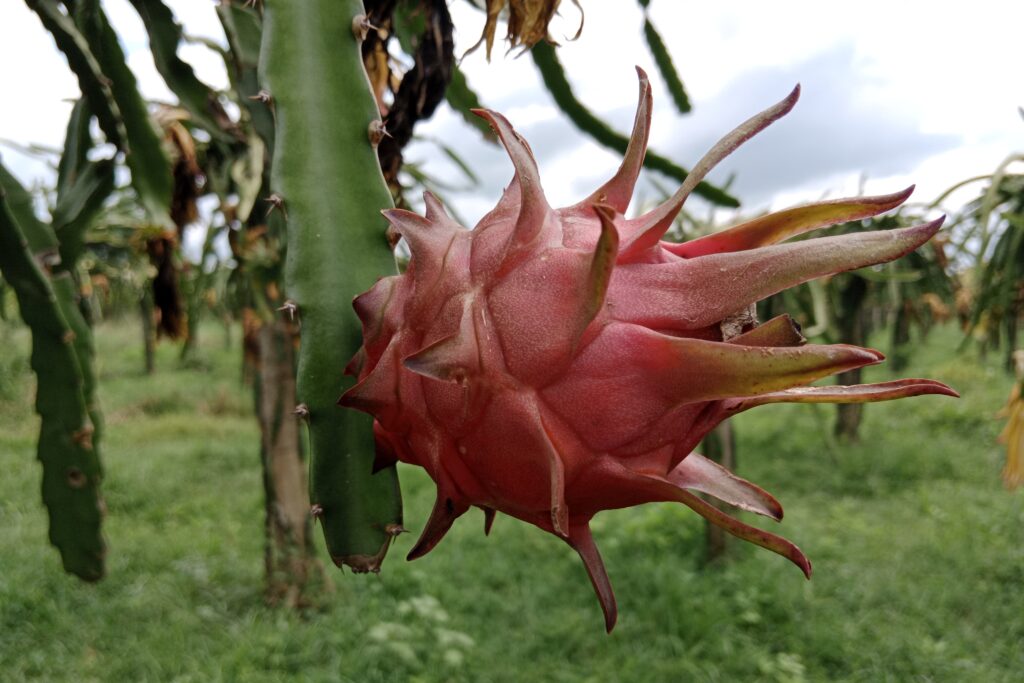Turnip Farming
Turnip (Brassica rapa) is a cool-season root vegetable cultivated primarily for its edible roots and leafy greens. It performs best in well-drained, fertile soils under moderate temperature conditions, making it suitable for both spring and fall production. Turnips are highly valued for their mild, slightly peppery flavor, rapid growth cycle, and rich nutritional profile, including essential vitamins, minerals, and dietary fiber, positioning them as a versatile and economically important crop in both small- and large-scale farming systems.
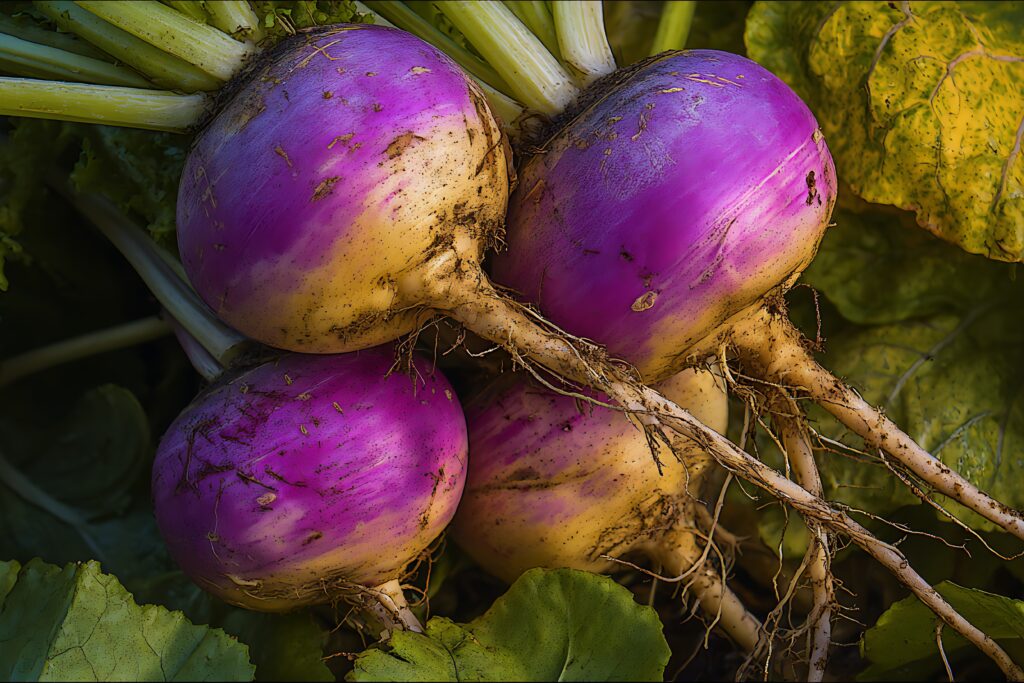
Turnip farming profit per acre offers significant income potential, with a total investment of 49,000 NRs per acre and an estimated total income of 240,000 NRs, yielding a profit of approximately 191,000 NRs per acre. This translates to a profit margin of around 79.6% and a return on investment (ROI) of about 3.9 times. The major costs include land preparation, fertilizers, and harvesting, while income is mainly determined by yield and market prices. Careful management of pests, weeds, and irrigation can further boost profitability by minimizing potential losses.
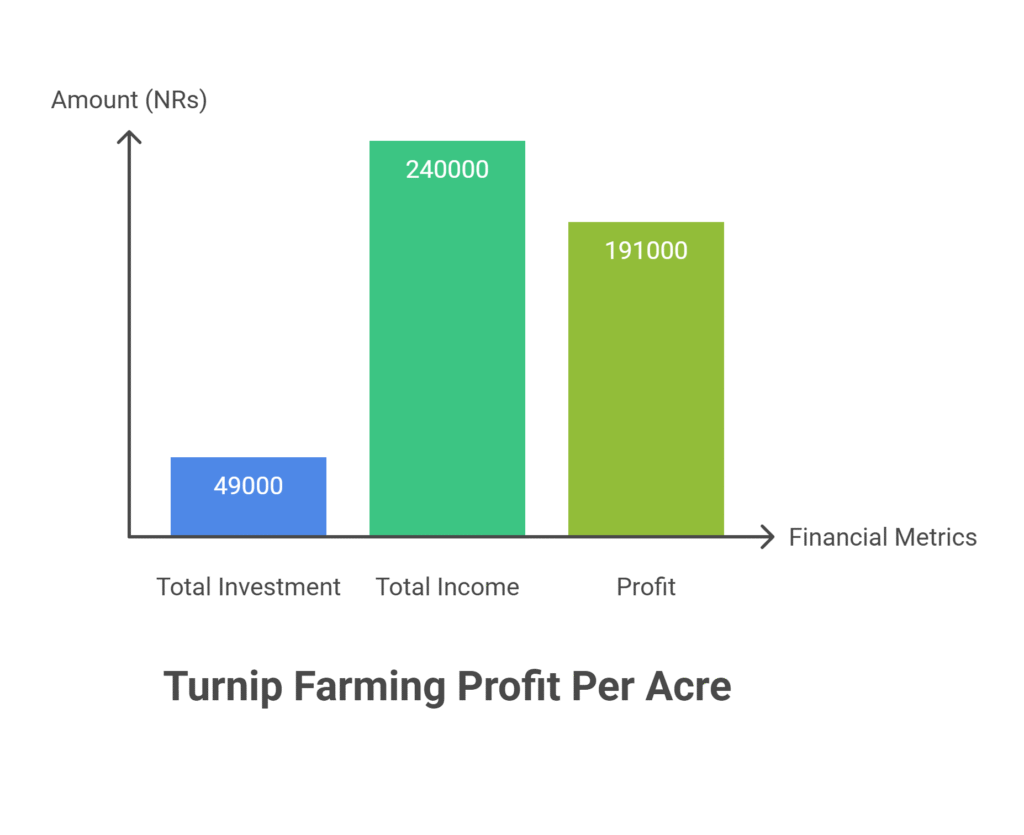
Land Preparation
Land preparation involves deep ploughing to a depth of 20–25 cm followed by 2–3 harrowings to break clods, ensuring a fine, crumbly soil texture for optimal root development. The field should be properly leveled for uniform irrigation and germination, while raised beds of 15–20 cm height or flat beds can be prepared depending on soil drainage, with a typical width of 1–1.2 m. Additionally, all weeds, stones, and residues of previous crops should be removed to maintain a clean and well-prepared seedbed.
Soil Type
A well-drained, deep sandy loam or loamy soil that is rich in organic matter is excellent for cultivation. The crop can withstand a pH range of 5.0 to 7.5, but growth is adversely affected by extremes. Avoid waterlogged or extremely stony soils, as well as heavy clay soils that result in poor drainage and malformed roots.
Climatic Requirements
Turmeric is a cool-season crop that grows best under cool to moderate temperatures. Both temperature and light play a major role in determining the development of the plant and the quality of its rhizomes throughout the growing period.
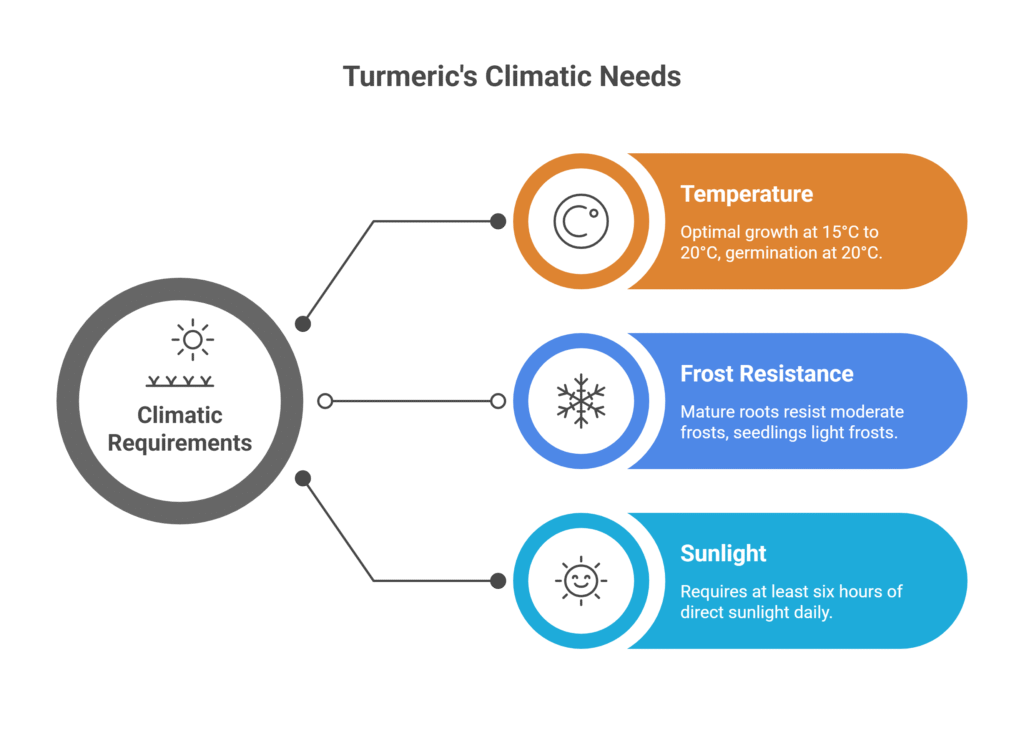
Turmeric grows best at temperatures between 15°C and 20°C. Although germination can take place in a larger temperature range of 10°C to 30°C, it is most successful at about 20°C. Temperatures around 20°C are ideal for root development, but extended exposure to heat exceeding 30°C frequently causes poor root production, bitterness, and early flowering (bolting).
Additionally, turmeric exhibits some resistance to frost. Mature roots can withstand moderate frosts, which may even intensify sweetness, while young seedlings can withstand light frosts. Turmeric needs at least six hours of direct sunshine per day to maintain healthy growth and guarantee a strong output because it is a sun-loving crop.
Major Cultivars
The choice of turmeric cultivar depends on several factors, including the shape of the roots (round, flat, or cylindrical), their color (white, yellow, or purple-topped), and the maturity period (early, mid, or late). Some cultivars are also selected for their leaf type, especially when grown for tender greens. Regional adaptability plays a key role, as varieties perform differently under specific soil and climate conditions.
| Variety | Description | Key Characteristics |
| Purple Top White Globe | The most common variety. | Purple shoulders, white base, globe-shaped roots. |
| Tokyo Cross | A fast-maturing variety. | Smooth, white roots. |
| Hakurei | A salad-type turnip known for its sweetness. | Smooth white skin and a sweet, mild flavor. |
| Golden Ball/Yellow Globe | A variety with distinctive yellow flesh. | Yellow-fleshed with a milder flavor profile. |
| Seven Top | A variety cultivated primarily for its leafy greens rather than its roots. | Grown for its greens; roots are secondary. |
| Scarlet Queen | A visually distinct variety with colorful skin. | Notable for its vibrant red-skinned roots. |
Propagation
Turnips are propagated exclusively through seeds, which are sown directly into the field. Direct seeding ensures proper root development, as the crop is very sensitive to disturbance. Transplanting is generally not recommended because it can damage or deform the roots, leading to poor yield and lower quality produce.
Seed Rate per Acre
The recommended seed rate for turnips is 1.0 to 1.5 kg per acre.
Planting
a). Planting Season
The main planting season for turnips is in September to October, as roots harvested after a light frost are sweeter and of better quality, while in mild winter regions, seeds can also be sown in November to December for a winter or early spring harvest.
b). Spacing
Turnips need to be spaced about 30 cm apart between rows and 10 cm apart within each row to promote healthy growth and optimal development.
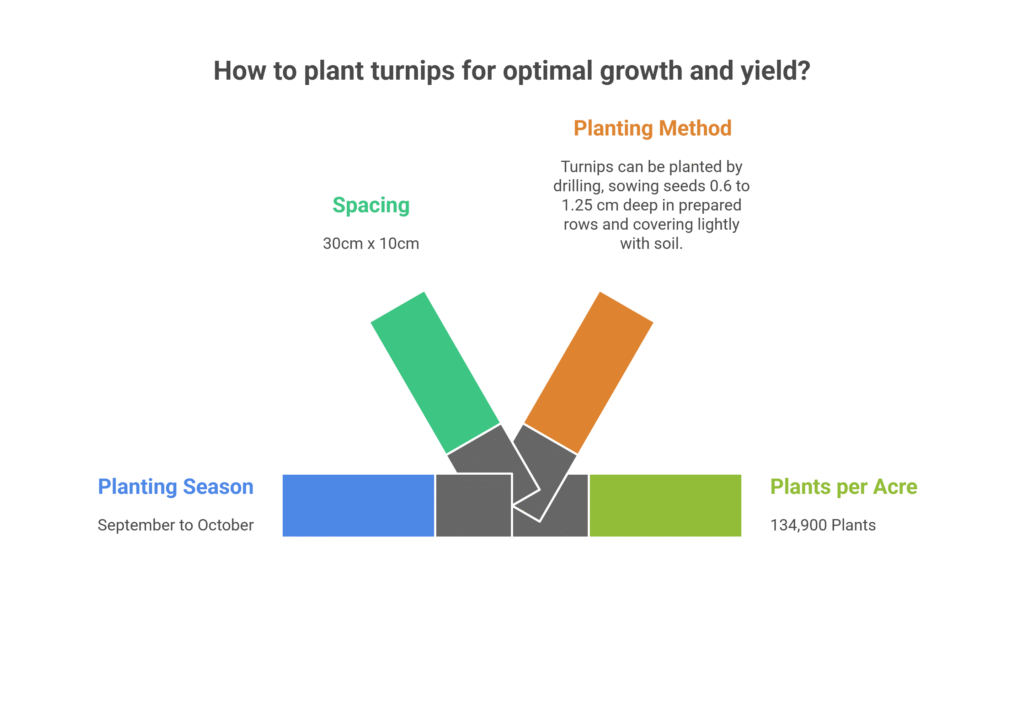
c). Planting Method
Turnips can be planted by drilling, sowing seeds 0.6 to 1.25 cm deep in prepared rows and covering lightly with soil.
d). Number of Plants per Acre
Turnip cultivation typically results in approximately 134,900 plants per acre.
Intercropping
Turnips can be intercropped with fast-maturing crops like lettuce, spinach, radish, or dill, and may also be grown alongside taller, slower crops such as maize if planted early, but should not be combined with other brassicas like cabbage or broccoli to avoid shared pests and diseases, allowing farmers to maximize land use during the short growing season.
Irrigation
Irrigation is critical for turnips during germination, root initiation (3–4 weeks after sowing), and root bulking, with light, frequent watering every 3–5 days needed for uniform germination and smooth root development; furrow irrigation is commonly used, while drip irrigation is more efficient as it conserves water and reduces leaf diseases, but overwatering or waterlogging should be avoided to prevent root rot.
Fertilizer and Manure
Performing a soil test is crucial to accurately assess and apply the right amount of fertilizer and manure for healthy turnip cultivation.
| Category | Recommendation | Application Method / Notes | |
| Organic Matter | 10-15 tonnes of well-rotted Farmyard Manure (FYM) or compost | Incorporated into the soil during land preparation. | |
| Biofertilizer | Azospirillum (800g) Phosphate Solubilizing Bacteria (PSB) (800g) Potassium Mobilizing Bacteria (800g) | Apply as recommended (e.g., seed treatment, soil application). | |
| Inorganic Fertilizer | |||
| • Nitrogen (N) | 50-70 kg | Split application: 50% at planting, remaining 50% applied 3-4 weeks later. | |
| • Phosphorus (P₂O₅) | 40-60 kg | Applied basally (placed in the soil at the time of planting). | |
| • Potassium (K₂O) | 50-80 kg | Applied basally (placed in the soil at the time of planting). | |
| Micronutrients | Borax (1-2 kg) | Apply according to soil test report at planting to prevent “brown heart” in turnips. | |
Weed Control
Weed control is crucial in turnip cultivation, as young seedlings are highly vulnerable to competition; effective methods include applying pre-emergence herbicides like Pendimethalin after sowing but before germination, performing shallow cultivation or careful hoeing between rows early to avoid root damage, conducting hand weeding within rows after thinning, and using organic mulches such as straw to suppress weeds and retain soil moisture.
Flowering and Fruit Management
Bolting in turnips refers to premature flowering, which can be triggered by prolonged cold exposure (vernalization) in young plants or by high temperatures later in the season. When bolting occurs, the roots become woody and inedible, reducing crop quality.
To manage bolting, farmers should select bolt-resistant cultivars, sow seeds at the appropriate time for their local climate to avoid early spring cold snaps, and minimize plant stress caused by drought or nutrient deficiencies. Since turnips are cultivated for their roots and leaves rather than fruit, it is important to harvest before bolting begins.
Pest and Disease Management
Common Pests
a) Flea Beetles
Flea beetles chew small holes in turnip leaves, especially affecting seedlings and young plants. To manage them, row covers can physically protect plants. Chemical control includes pyrethrins at 0.5–1.0 g/L or carbaryl at 2 g/L applied as a foliar spray. Neem oil (2–3 mL per liter of water) can also be used as a natural, eco-friendly option.
b) Aphids
Aphids can spread viral infections and consume the sap of plants. Neem oil at 2-3 mL/L or insecticidal soap at 2-3 mL per liter of water are examples of control techniques. Aphid populations can be managed without the use of chemicals by promoting ladybugs and other natural predators.
c) Cabbage Root Maggot
The larvae of cabbage root maggots feed on turnip roots, causing stunted growth or plant death. Effective management includes using row covers with sealed edges, applying beneficial nematodes (Steinernema spp.) to the soil, or, in severe infestations, applying diazinon at 0.5–1.0 g/L as a soil drench around seedlings.
d) Cutworms
Cutworms cut seedlings at the soil line, often killing young plants. Protective measures include placing collars around seedlings or using cutworm baits according to the label instructions. Maintaining clean, weed-free fields can also reduce cutworm populations.
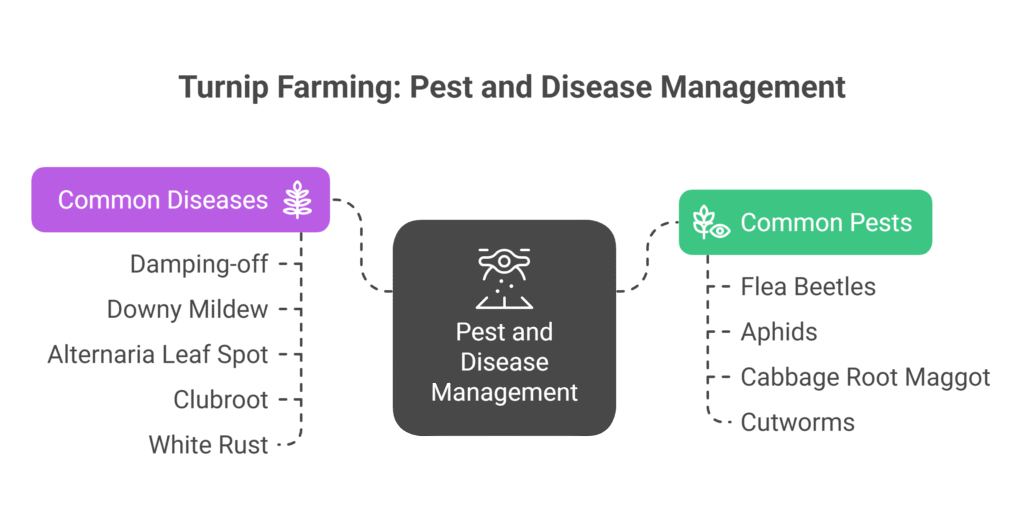
Common Diseases
a) Damping-off (Pythium, Rhizoctonia)
Damping-off causes seedling rot, leading to poor germination and weak seedlings. Management includes ensuring well-drained soil and avoiding overwatering. Using fungicide-treated seeds is effective; for example, treating seeds with thiram or captan at 2–3 g per kg of seed helps prevent early infections.
b) Downy Mildew
On leaves, downy mildew manifests as yellow patches with a white growth that resembles mold on the underside. Planting resistant cultivars, making sure there is enough space for airflow, and using foliar sprays of fungicides like copper oxychloride (2–3 g/L) or mancozeb (2–3 g/L) are some control methods.
c) Alternaria Leaf Spot
Alternaria leaf spot causes dark, circular spots on leaves, reducing photosynthesis and overall yield. Management involves crop rotation and applying chlorothalonil at 2–2.5 g/L as a foliar spray when symptoms appear.
d) Clubroot (Plasmodiophora)
Clubroot leads to swollen, distorted roots and stunted plant growth. Control includes implementing a long crop rotation of 7+ years, liming soil to maintain pH above 7.0, and planting clubroot-resistant varieties. Chemical treatments are generally not effective against this soil-borne pathogen.
e) White Rust (Albugo)
White rust causes white pustules on leaves and stems, reducing quality and yield. Management involves crop rotation and foliar fungicide sprays such as mancozeb at 2–3 g/L to prevent infection. Ensuring good plant spacing also reduces disease incidence.
Harvesting
Turnip roots should be harvested when they reach the desired size, usually 5–10 cm (2–4 inches) in diameter, typically 40–60 days after sowing. Roots should be collected before they become woody or pithy, while fall crops can be harvested after light frosts for better sweetness. Young leaves can be harvested anytime when they are 5–6 inches long, or the entire tops can be collected along with the roots.
To harvest roots, gently loosen the soil with a fork or spade and pull the plants by the base of the leaves. Trim the tops to 1–2 inches above the crown to reduce moisture loss. For greens, cut individual leaves or the entire tops using a sharp knife.
Yield
The typical root yield of turnips ranges from 10,000 to 15,000 kg per acre.
Cost of Investment Per Acre for Turnip Farming
| S.N. | Categories | Cost of Investment (NRs.) |
| 1 | Land Preparation | 15,000 |
| 2 | Seed | 1,000 |
| 3 | Sowing | 2,000 |
| 4 | Fertilizers and Manure | 8,000 |
| 5 | Irrigation | 5,000 |
| 6 | Weed Control (pre & post-emergence) | 3,000 |
| 7 | Pest & Disease Control | 3,000 |
| 8 | Harvesting | 7,000 |
| 9 | Miscellaneous Costs | 5,000 |
| Total Cost | 49,000 |
Income per Acre for Turnip Farming
| Particulars | Estimated Yield per Acre (kg) | Market Price (NRs/kg) | Total Income (NRs.) |
| Turnip Yield | 12,000 | 20 | 240,000 |
Analysis of Turnip Farming Profit Per Acre
| Metric | Calculation | Amount (NRs.) |
| Total Income | 240,000 | |
| Total Investment Cost | 49,000 | |
| Net Profit | 240,000 – 49,000 | 191,000 |
| Profit Margin | (191,000 / 49,000) × 100 | ~390% |
Turnip farming has a high-profit potential, with a total investment of 49,000 NRs per acre and an estimated total income of 240,000 NRs, resulting in a profit of approximately 191,000 NRs per acre. The profit margin is about 79.6% (profit ÷ total income × 100), and the return on investment (ROI) is roughly 3.9 times (profit ÷ investment). The main expenses are for land preparation, fertilizers, and harvesting, while the income is primarily driven by yield and market price. Efficient management of pests, weeds, and irrigation can further enhance profitability by reducing potential yield losses.
Crop Calendar
| Step | Activity | Recommended Timing | Details / Notes |
| 1 | Land Preparation | 2–3 weeks before sowing | Plow or till the field 2–3 times to make soil fine and well-drained. Add compost or well-rotted manure (2–3 tons/acre) and balance fertilizers based on soil test. |
| 2 | Seed Selection | Before sowing | Use high-quality, disease-free seeds. Select cultivars suitable for local climate and market demand. |
| 3 | Sowing / Planting | Spring: Feb–Mar Fall: Sep–Oct Mild winter regions: Nov–Dec | Direct seed in rows with 30 cm between rows and 10 cm within rows. Sow at 0.6–1.25 cm depth (drilling) or broadcast and thin carefully. |
| 4 | Irrigation | Immediately after sowing and regularly thereafter | Keep soil consistently moist during germination and root development. Light irrigation every 3–5 days is recommended. Avoid waterlogging. |
| 5 | Fertilization | 2–3 weeks after germination, and mid-growth | Apply nitrogen-rich fertilizer for leaf growth and balanced NPK for root bulking. Use soil test recommendations. |
| 6 | Weed Control | 2–6 weeks after sowing | Pre-emergence herbicides (e.g., Pendimethalin 1–2 g/L) or shallow hoeing. Hand weed within rows after thinning. Mulching can suppress weeds. |
| 7 | Pest & Disease Management | Throughout growth | Flea beetles, aphids, cutworms, root maggots, and diseases like damping-off, downy mildew, leaf spot. Apply recommended insecticides/fungicides (follow doses) and use cultural controls. |
| 8 | Thinning / Plant Maintenance | 2–3 weeks after germination | Thin seedlings to 10 cm spacing within rows to ensure proper root development. |
| 9 | Flowering & Bolting Management | As plants mature | Avoid stress, select bolt-resistant varieties, and harvest before bolting. |
| 10 | Harvesting Roots | 40–60 days after sowing | Harvest roots 5–10 cm in diameter. Loosen soil gently and trim tops to 1–2 inches. Fall crops can be harvested after light frost. |
| 11 | Harvesting Greens | 30–50 days after sowing (or anytime for young leaves) | Cut individual leaves 5–6 inches long or harvest entire tops along with roots. |
| 12 | Post-Harvest Handling | Immediately after harvest | Clean roots and greens, avoid bruising, store in cool, dry conditions, and transport promptly to market. |
Sources
Food and Agriculture Organization (FAO)
University of California Agriculture & Natural Resources (UC ANR)
European Plant Protection Organization (EPPO)
Punjab Agricultural University (PAU)
Tamil Nadu Agriculture University (TNAU) – Agritech portal
Indian Council of Agricultural Research (ICAR)
Nepal Agricultural Research Council (NARC)
U.S. Department of Agriculture (USDA).
Ministry of Agriculture and Livestock Development (Nepal)

